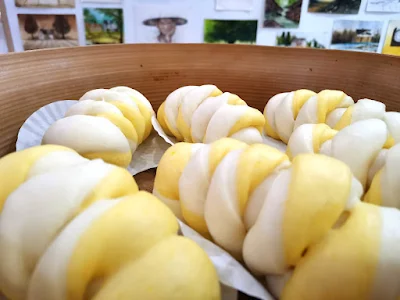Twisted Pumpkin Steamed Bun
A twisted pumpkin steamed bun is what I'm going to share today. Two different colours of
dough—yellow dough and white dough—were used to make this twisted pumpkin
steamed bun. These twisted steamed buns have a pillowy, light, and fluffy dough
that is twisted into its unique shape and steamed to perfection. Because of its
golden orange colour, it is extremely beautiful.
Our main character pumpkin is
necessary to prepare pumpkin bread. Chestnut squash is the best, which
tastes even better. This pumpkin's high starch content makes it
ideal for this recipe. Of course, you can use other types of pumpkins.
These bi-coloured pumpkin buns are
soft and have a faint pumpkin flavour in the mouth. The more you chew, the more
you bring the fragrant out when the two colours of dough are rolled and twisted
together, you will see a distinct layer of dough.
Let me tell you that there is another exciting method to enjoy this bi-coloured pumpkin bun. Place some sliced cheese on top of the bun the following day before steaming it again. The kids will be attracted to the gorgeous bun's melted cheese top layer!!
DO I HAVE TO ADD ALL THE WATER TO THE
DOUGH?
The common practice is to add a little water if the dough feels too dry.
In fact, holding back a little of the water from the recipe, and adding it in
incrementally, going by feel rather than measurement, is the preferred way to
get a perfect dough.
DO I NEED TO WINDOWPANE TEST THE DOUGH?
You are not making bread dough. So, you do not have to do a windowpane
test with the dough. As far as the dough is smooth, shiny, and elastic.
TYPE OF FLOUR TO USED FOR STEAMED BUN
The choice of steamed bun flour is very important. Flour is divided into
high-gluten flour, medium-gluten flour, and low-gluten flour. Steamed buns made
with high-gluten flour is firmer and chewier which is not a preference. White
medium-gluten flour is softer. So, it depends on your preference. I am using
Hong Kong flour (also known as pao flour). It is like cake flour, which is
highly blenched. It is recommended for making Chinese steamed buns.
HOW TO FERMENT THE DOUGH?
Prepare a pot with water for steaming. Turn off the heat after the water
in the steamer is boiled. Keep the bamboo steamer on the kitchen top which is
beside the streamer.
HOW LONG DOES IT TAKE FOR THE SECOND FERMENTATION?
To ensure that the steamed buns are soft and fragrant, they usually carry
out secondary fermentation. I set 30 minutes for the second fermentation. But
the dough already rises at 20 minutes. You may observe from both sides of the dough
already puffed up.
INGREDIENTS (PUMPKIN DOUGH)
240g flour (Hong Kong flour)
150g pumpkin (steamed and mashed)
70g sugar
¼ tsp salt
1 Tbsp cooking oil
1 Tbsp warm water
1 tsp baking powder
1 tsp instant yeast
INGREDIENTS (WHITE DOUGH)
290g flour (Hong Kong flour)
70g sugar
1 Tbsp cooking oil
150 ml warm water
1 tsp baking powder
1 tsp instant yeast
1) Peel and cut the pumpkin into small cubes. Steam in the streamer for
15 minutes or until you can easily be mashed with a fork.
2) In a large bowl of your electric mixer, add in all the ingredients
except oil, and beat until all combined. Then add the mashed pumpkin and beat
until incorporated. If the dough feels too dry, add another tablespoon of
water. Once the dough is smooth and elastic add the cooking oil and continue
beating on medium-low speed until the oil is completely incorporated and the
dough is smooth, shiny, and elastic.
3) Leave the dough on the table covered with plastic wrap or a bowl, and
let the dough rest for 5 minutes, to let the dough looks much smoother and well
relaxed.
4) While the pumpkin dough is resting on the table. Make the white dough
follow exactly the step as the pumpkin dough.
5) Divide EACH dough into 6 pieces, 100g each. Mould them into
balls and cover them with plastic wrap.
6) Roll the two pieces of dough into 8” x 4 rectangular sizes. Layer the
white dough underneath and the yellow dough layer on top. Or vice versa. Brush
some water on the overlapping dough, to let the two pieces of dough stick together. Cut into 6 even strips, leaving about 2cm of
the top uncut. Create flowers by twisting the cut strips. Press the bottom to
help seal after precisely arranging the twisted strips. From top to bottom,
roll up. Make sure you tuck and roll the
dough, so it forms a tight log. Press from the side to let the cut strips stick
together as well.
7) Placed the steaming paper underneath each dough, then keep it in a
bamboo steamer, to let it proof for 30 minutes or double in size. Make sure you
are leaving room for rolls to rise, so they do not stick together after rising.
Hope you find this guide useful and
enjoy this super soft and beautiful pumpkin steamed bun with cheese to the
fullest.





Comments
Post a Comment